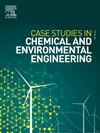Enhanced performance of visible-light-induced Bi2MoO6–N-doped biochar for rhodamine B degradation and textile wastewater decontamination
Q1 Environmental Science
Case Studies in Chemical and Environmental Engineering
Pub Date : 2024-12-29
DOI:10.1016/j.cscee.2024.101090
引用次数: 0
Abstract
Organic dyes are a significant source of growing wastewater pollution. Biochar-supported visible-light photocatalysts are gaining attention due to their cost-effectiveness and green perspective. This study presents a novel N-doped-coconut-husk-derived biochar (NBC)-supported bismuth molybdate (BMO) as a photocatalyst. Urea, KOH were mixed with coconut-husk and pyrolyzed at 600–800 °C to prepare NBC. The ball-mill mixed BMO-NBC composites having 77 wt% BMO-23 wt% of 800 °C pyrolyzed NBC degraded 99.1 % of 10 mg/L RhB solution within 120 minutes. The photocatalyst was evaluated for on-site-collected textile-effluent remediation. The role of biochar functionalization, pyrolysis temperature, as well as composite composition, in its photocatalytic performance, are presented.

增强可见光诱导bi2moo6 - n掺杂生物炭对罗丹明B的降解和对纺织废水的去污性能
有机染料是日益严重的废水污染的重要来源。生物炭支持的可见光催化剂因其成本效益和绿色前景而受到关注。本研究提出了一种新型的n掺杂椰子壳衍生生物炭(NBC)负载钼酸铋(BMO)作为光催化剂。尿素、KOH与椰子壳混合,在600 ~ 800℃下热解制得NBC。球磨混合BMO-NBC复合材料含有77%的bmo - 23%的800°C热解NBC,在120分钟内降解99.1%的10 mg/L RhB溶液。对光催化剂在纺织废水现场修复中的应用进行了评价。介绍了生物炭功能化、热解温度和复合成分对其光催化性能的影响。
本文章由计算机程序翻译,如有差异,请以英文原文为准。
求助全文
约1分钟内获得全文
求助全文
来源期刊

Case Studies in Chemical and Environmental Engineering
Engineering-Engineering (miscellaneous)
CiteScore
9.20
自引率
0.00%
发文量
103
审稿时长
40 days
 求助内容:
求助内容: 应助结果提醒方式:
应助结果提醒方式:


